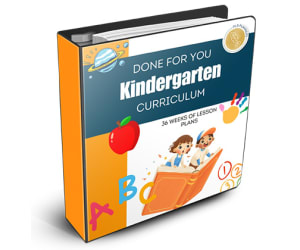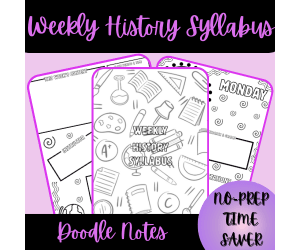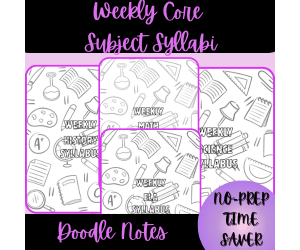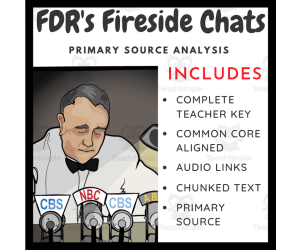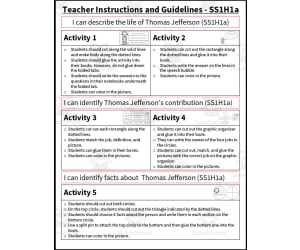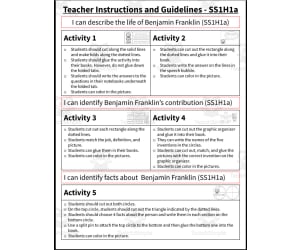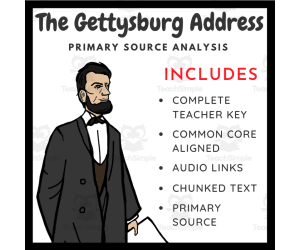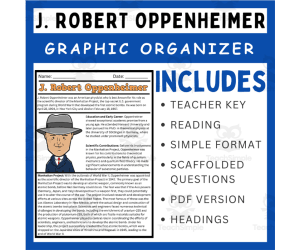2,760 products added recently
Social Studies Graphic Organizers
Support your social studies curriculum with graphic organizers designed to help students process historical events, cultural practices, and societal structures. These resources facilitate critical thinking and make connections clearer. Use them to enrich discussions and deepen comprehension in your social studies classes.
Black History Month Juneteenth Biography Reading Graphic Organizer 4-5
Common Core, ELA, Social Studies, Reading, Reading Comprehension, Biographies, Grade 4, 5, 6, Activities, Crafts, Graphic Organizers, Teacher Tools
Introduce learners to the amazing lives of Black History Month and Juneteenth pioneers and personalities through this Black History Month | Juneteenth Pioneers Study Pack. Meticulously made for Graders 4, 5, 6, EFL/ESL students and homeschoolers, this jam-packed resource set includes: 2 SETS of 12 Pioneer Biographies Reading Comprehension (COLORED AND BLACK&WHITE SETS) Featuring: 1. Langston Hughes 2. Thurgood Marshall 3. Sojourner Truth 4. Martin Luther King Jr. 5. Sarah E. Goode 6. Wilma Rudolph 7. Billie Holiday 8. Bessie Coleman 9. George W. Carver 10. Phyllis Wheatley 11. Booker T. Washington 12. Ruby Bridges Foldable Biography Graphic Organizers for each pioneers Pioneers Cryptogram Quotes The biography reading comprehension set presents our special pioneers’ story that the students can explore and study. Through the reading texts, they can then complete the foldable graphic organizers that are perfect assessment project and even a perfect showpiece for open house programs! Finally, the cryptogram quote exercises are fun, yet purposeful, activities that the students can do as part of their reading exercise and a perfect addition to morning works. This Black History Month / Juneteenth Study Pack is perfect for ELA, social studies, reading comprehension, and reading project– a valuable resource in your teacher toolbox!
Author It's Teacher L
Tags Black History Month, Juneteenth, Black History Month Biographies, Reading Comprehension, Graphic Organizers, Biography Graphic Organizers, Cryptograms
Kindergarten Full Curriculum PowerPoint Bundle | 36 Weeks of Editable
ELA, Math, Science, Social Studies, Special Resources, P.E. & Health, Kindergarten, Lesson Plans, Teacher Tools, Graphic Organizers, Literacy Readers
Make your planning easy with this complete Kindergarten Curriculum PowerPoint Bundle. This bundle gives you 36 weeks of ready-to-use lessons for the full school year. It includes 1,202 editable slides across four PowerPoint files. You can open the files, teach the lessons, and adjust anything to fit your class. It saves time and supports consistent, engaging instruction. Language and literacy, math, science, social studies, arts, physical education, and social and emotional development are all covered each week. Lessons help young students develop strong early skills and adhere to specific learning objectives. A presentation guide, a diploma for students, and an end-of-year capstone project with straightforward instructions are all included in the bundle. Use these slides for digital instruction, centers, morning meetings, small groups, and whole-class instruction. Pages for practical exercises can also be printed. Both homeschooling and classroom settings benefit greatly from this resource. Teachers adore this curriculum's comprehensiveness, adaptability, and structure. This full-year customizable bundle will give your kindergarten curriculum structure and originality. Get it and begin instructing right now.
Author Bright Classroom Ideas Marketplace
Rating
Tags Kindergarten, Curriculum, Lesson, Plan, Math, Ela, Science, Social, Project, Worksheet
Weekly History Syllabus Doodle Notes
Creative Arts, Graphic Arts, ELA, Writing, Resources for Teachers, History, Social Studies, High School, Homeschool Resources, Middle School, Worksheets & Printables, Writing Prompts, Teacher Tools, Graphic Organizers, Outlines, Templates
Ever feel like your history lessons need a serious pick-me-up? After watching my teenager's eyes glaze over during one too many timeline activities, I knew I had to create something different! These Weekly History Syllabus Doodle Notes were born late one night at my kitchen table, surrounded by scattered history books and half-finished lesson plans that weren't working for either of us. As a fellow homeschool mom who's navigated the treacherous waters of teaching history to a teenager (who'd rather be doing ANYTHING else), I have poured all my real-world experience into these templates. Gone are the days of dry, boring history planning that puts both of us to sleep! Instead, I have created visual planning sheets that finally clicked for my visually-oriented teen. Now we're mapping out historical connections, documenting primary source readings, and planning research activities in a way that actually sticks! The magic happens when those historical concepts come alive through both organized planning AND creative visual elements. My daughter went from "Do we have to do history today?" to pointing out connections between historical periods on her own—I amnot kidding! These templates have completely transformed how history works in our homeschool, and I cannot wait for them to do the same for yours. INCLUDED IN THIS RESOURCE: Comprehensive weekly history planning template with visually engaging design Designated spaces for historical learning objectives, content focus, and instructor information Daily sections for documenting classwork, discussions, quizzes, and attendance Specialized reading assignment sections for historical texts and primary sources Homework planning areas with website research recommendations and writing prompts Visual note-taking spaces that connect historical concepts with creative representation Structured organization that accommodates the unique narrative nature of history instruction Look, I am not going to pretend I'm some super-organized homeschool mom with color-coded bookshelves (my laundry pile would quickly disprove that myth!). But after years of history lessons that felt like pulling teeth, these doodle notes have honestly saved our homeschool history curriculum. Sunday afternoons used to find me stressed and overwhelmed, staring at history books and wondering how to make centuries-old events relevant to my tech-obsessed teen. Now? I actually look forward to mapping out our history week! The combination of chronological organization with visual creativity means concepts stick in a way they never did before. My daughter has gone from glazed-over eyes to making connections between historical periods on her own. No joke—last week she compared political patterns from ancient Rome to something in today's news WITHOUT PROMPTING! Grab these templates today, and in a few weeks, you will be texting your homeschool friends about how your kid suddenly loves history. (And they'll demand to know your secret!) If you and your students/homeschoolers enjoyed this resources, please leave a review. Thank you for your support! Tina - Big Easy Homeschooling Mom Please subscribe: tidewindacademyhomeschool.com
Author Homeschool with Big Easy Homeschooling Mom
Rating
Tags History Doodle Notes, Visual Aids, Visual Learning Tools, Social Studies Planning, History Syllabus Templates, Doodle Notes, Homeschool History Organization, Homeschool Social Studies Organization Tools, Weekly History Planning Templates For Homeschoolers, Educational Organization
Weekly Core Subject Syllabi Doodle Notes Bundle
Creative Arts, ELA, Writing, Math, Science, Social Studies, Resources for Teachers, High School, Homeschool Resources, Middle School, Worksheets & Printables, Writing Prompts, Teacher Tools, Graphic Organizers, Outlines, Templates
Let's be honest, juggling ELA, Math, History, and Science in our homeschool week can feel overwhelming, right? I have created something that has been a game-changer: this Weekly Core Subject Syllabi Doodle Notes Bundle ! It is like a breath of fresh air – instead of dreading lesson planning, it's actually become kind of fun! These templates use a mix of visual learning and practical organization, which means I'm not scrambling to remember anything, and my teen is way more engaged. Seriously, say goodbye to those boring, dry lesson plans and hello to a colorful and effective way to map out our learning week! INCLUDED IN THIS RESOURCE: ✔Weekly ELA Syllabus Doodle Notes ✔Weekly Math Syllabus Doodle Notes ✔Weekly History Syllabus Doodle Notes ✔Weekly Science Syllabus Doodle Notes ✔Structured templates for daily planning ✔Visually engaging doodle elements This Weekly Core Subject Syllabi Doodle Notes Bundle has truly transformed how I approach our core subjects. By pairing practical organization with those awesome visual learning principles, it's empowered me to create weekly plans that are actually clear, effective, and – believe it or not – enjoyable! It's been amazing to watch my teenager be more engaged and get more involved, organized, and even excited about learning. It is all thanks to a planning system that speaks to both the logical and creative sides of how they learn. If you are looking for a way to streamline your homeschool and make it more inspiring, definitely give this bundle a try! If you and your students/homeschoolers enjoyed this bundle, please leave a review. Thank you for your support! Tina - Big Easy Homeschooling Mom
Author Homeschool with Big Easy Homeschooling Mom
Rating
Tags Weekly Core Subject Syllabi Doodle Notes, Weekly Planners For Students/homeschoolers, Student Engagement, Student Organization, Engaging Syllabi Templates, Subject-specific Planners, Weekly Doodle Notes, Homeschool Curriculum Planner, Syllabus Templates
WORLDLE Country of the Day: An Easy Routine for World Geography
Social Studies, Geography, Grade 4, 5, 6, 7, 8, 9, Teacher Tools, Graphic Organizers
Here's an easy way to incorporate world geography into your classroom routine! How to Use: Play WORLDLE with your class: https://worldle.teuteuf.fr/ It's a game inspired by WORDLE but using images of countries instead. It's a great way to also practice, percentages, compass directions and distances, as incorrect guesses are given information about how far they are from the actual country, in what direction, and what percentage accuracy your guess had. After you have determined the country of the day, students can spend a few minutes learning about it and recording basic facts on the handout (you can print it double-sided, so 12 countries fit on a sheet). Students need to identify which continent the country is part of, find its current population, the capital city, countries that are neighbours, the official language or languages, and two fun facts. This website is a great resource for learning about each country: https://www.kids-world-travel-guide.com/ If you play for a whole school year, you should have time to learn about most of the countries in the world! You could also let students choose different countries from the game to research more in depth and present to one another. Grades to Use With: This is an easy routine to use in your grades 4-9 classrooms. It could be a morning homeroom activity as kids arrive each day or something to help the class settle after lunch. You could also use it during social studies or geography lessons as a quick break or reward. If you enjoy this social studies product, check out others in my store: United Nations Declaration on the Rights of Indigenous Peoples Political Spectrum: Handout, Sorting Task, Local Research and Reflection Critical Thinking: Income Inequality: An Integrated Math and Social Studies Lesson
Author Grace Under Pressure
Tags Worldle, World Geography, Daily, Routine, Countries, Map, Earth, Social Studies, Homeroom, Morning Routine, What Is Today's Worldle Country, Worldle Country Today, Worldle Geography Today, World.teuteuf.fr, Worldle Geography Website, Worldle Today Country, What Is The Worldle Country Today, What Is Todays Worldle Country, Worldle Countey, Worldle World Map Game, Worldle Countrie, Worldle Country Wordle, World Teuf Teuf, Worldel Country, Worldle County, Worldle World Map, World. Teuteuf. Fr, Wordle Geography Website, Worldle World Wordle, World Teuteuf Fr
Bering Land Bridge - Graphic Organizer & Mapping Activity
Social Studies, History, History: USA, History: World, Grade 6, 7, 8, 9, Teacher Tools, Graphic Organizers
The Bering Land Bridge - Graphic Organizer & Mapping Activity This is a robust teaching resource crafted for grades 6 through 9 USA History and World History classes. It uniquely blends key concepts with strategies for note-taking, fostering an environment ripe for educational growth. Main Features: Specially made to help students grasp the major events surrounding the crossing of the Bering Land Bridge by hunter-gatherers. Features student-centric and instructor-focused notes, encouraging active content engagement while supporting teachers during instruction. Acts as a bridge between theory and practice, complementing classroom readings with additional ideas to stimulate insightful discussions. The built-in reading activity about the Bering Land Bridge, is an interactive exercise allowing students to understand about human migration patterns globally easily. The package also includes a mapping activity along with probing questions to further enhance comprehension levels across all learning stages. No extra purchases required; everything needed is included in this product bundle! The Power of Visual Aids: To promote knowledge retention effectively, this instructional resource incorporates relevant illustrations from Teachers Resource Force & Prince Padania. All these resources offer flexibility for adaptation - be they whole class activities, small group assignments or individual homework projects. In conclusion, any educator aiming to instill their students with thorough understanding of this global historical event will find 'The Bering Land Bridge - Graphic Organizer & Mapping Activity ' incredibly useful!
Author EduPal Learning
Tags Bering Land Bridge, Hunter-gatherers, Migration Patterns, Geographical Implications, Mapping Activity
FDR's Fireside Chats: Primary Source Analysis & Graphic Organizer
Social Studies, History, History: USA, Grade 8, 9, 10, 11, Teacher Tools, Graphic Organizers
Get ready to explore the captivating world of Franklin D. Roosevelt's Fireside Chats with our comprehensive Primary Source Analysis and Graphic Organizer resource, perfect for high school American History and Government classes. This well-rounded educational package is designed to help your students dive deep into the historical significance of President FDR's ground-breaking radio addresses. Our all-inclusive bundle is packed full of engaging materials that bring FDR's Fireside Chats to life in your classroom. Students will be encouraged to participate in stimulating activities such as examining a detailed background of the chats, analyzing carefully selected primary source excerpts, and pulling out key evidence from FDR’s speeches using an easy-to-follow graphic organizer . Witness your students' critical thinking skills flourish as they dissect first-hand accounts from two significant Fireside Chats – On Banking Crisis (1933) and On Farmers and Laborers (1936). They'll immerse themselves fully into these speeches while learning how to pinpoint their purpose & impact on public morale during volatile times in American history. This turnkey product has everything you need! You'll receive a digital teacher key alongside a student version, all available in printer-friendly PDF format. Don't miss this amazing opportunity to create memorable learning experiences for your students while connecting them with an unforgettable chapter of US Presidential history! Thumbnail Clipart Credit: Massare Clips and Design
Author EduPal Learning
Tags FDR, Roosevelt, Great Depression, Franklin D. Roosevelt, Fireside Chat, Primary Source , Analysis
The Antebellum South: Graphic Organizer
Social Studies, History, History: USA, Grade 7, 8, 9, 10, Teacher Tools, Graphic Organizers
The Antebellum South: Graphic Organizer The Antebellum South: Graphic Organizer is a vital teaching resource designed to aid educators in imparting students with an intuitive understanding of the complex societal, economic, and cultural facets of the pre-Civil War era in the Southern United States. This tool proves particularly beneficial for Grade 7 to Grade 10 educators dealing with social studies. Key Features: Insightful Understanding: Alongside explaining topics like slavery and socio-economic division prevalent in the antebellum south, this resource also provides insights into cotton and tobacco - cash crops extensively farmed on plantation farms using enslaved Africans. All-encompassing narrative: This graphic organizer weaves together crucial events such as Nat Turner's rebellion while tracing debates sparked by southern leaders justifying slavery based on economic compulsions which simultaneously raised discussions around racial hierarchy and states' rights.(Refer to appended teacher notes) Versatility: Suitable for whole-class discussions, group activities or assigned as individual research work due to its self-explanatory design. Tailored Resources: Presented in PDF format, The Antebellum South: Graphic Organizer includes both a teacher-prepared notes variant complete with comprehensive explanations and a student variant that promotes self-learning. Note:The uniqueness lies in this tool's succinct yet informative approach – allowing grades 7-10 students to effectively grasp historical contexts without compromising on factual integrity solely aimed at enhancing their educational pursuits. As an added bonus, thumbnail clipart supplied by Clip Art Emporium makes it visually engaging. Not requiring additional software or resources adds icing on the cake – just print it out and you're all set! Encoded with rich education values, this ready-to-use tool indisputably becomes a wonderful addition to any classroom.
Author EduPal Learning
Tags Antebellum South, Graphic Organizer, Social Studies, Slavery, Plantation Farms
New Deal Alphabet Agencies: Graphic Organizer
Social Studies, History, History: USA, Grade 7, 8, 9, 10, 11, Teacher Tools, Graphic Organizers
The New Deal was a series of economic programs and reforms implemented in the United States during the 1930s by President Franklin D. Roosevelt (FDR). It was a response to the severe economic crisis of the Great Depression, which began with the stock market crash in 1929. The New Deal aimed to address the widespread unemployment, poverty, and economic instability that plagued the country. Its primary goals were relief for the unemployed and those in need, economic recovery, and reform to prevent future economic crises. The New Deal consisted of three main components, often referred to as the "Three Rs": Relief, Recovery, and Reform. Overall, FDR's New Deal represented a significant expansion of the federal government's role in the economy and social welfare, aiming to provide relief to those in need, stimulate economic recovery, and establish long-term reforms to prevent future economic crises. Teacher-prepared notes show students what is important and how ideas relate, and offer a model for how students should take notes themselves (Marzano et al., 2001). This fill-in-the-blank graphic organizer is perfect for your student's interactive notebook. It looks at the 3 R's of the New Deal (Relief, Recovery, and Reform), and provides examples of agencies that aimed to fulfill those goals. Ready to use - no prep.
Author EduPal Learning
Tags New Deal, FDR, US History, Great Depression, Franklin Roosevelt, Deficit Spending , Graphic Organizer, Alphabet Agencies New Deal, What Were The Alphabet Agencies
September 11th, 2001: Graphic Organizer
Social Studies, History, History: USA, Grade 6, 7, 8, 9, 10, Teacher Tools, Graphic Organizers
Teaching about the monumental moments in history isn't just part of our job—it's a calling. One of those watershed moments, without a doubt, is the 9/11 attacks of 2001. Orchestrated by al-Qaeda, this day didn't just change the skyline of New York; it changed the fabric of the United States and shifted its trajectory on the global front. While many of us can still feel the weight of the smoke-filled air as we watched the World Trade Center towers fall, or the heartbreak hearing the tales of heroism from Flight 93, we must recognize that for a good number of our students, this day is a story from before their time. Our challenge—and indeed, our responsibility—is to bridge that gap, making the stories of that day both tangible and understandable. One way to navigate this is with clear, structured notes. Think of it as connecting the dots: breaking down complex events and pairing them with firsthand accounts, like President George W. Bush's immediate reactions, helps paint a fuller picture for our students. In our shared goal to enlighten and inform, I've put together a resource that walks through 9/11. For us educators, there's a comprehensive version, and for our students, an interactive one designed to pique their curiosity and encourage active participation. Ready to use, these tools are designed to make our task a tad easier while ensuring our students gain a thorough understanding. By weaving this resource into our lessons, we're taking our students by the hand and guiding them through one of the most consequential days in recent history. It's so vital they grasp the magnitude and nuances of such events, and I truly think this tool will be a cornerstone in that effort. This product comes with a completed teacher version and a fill-in-the-blanks version. Ready to print and ready to use. Great format to help students learn.
Author EduPal Learning
Tags September 11, Terrorist Attack, Trade Center, Twin Towers, World Trade Center, George W. Bush, Graphic Organizer
Cesar Chavez (2014): Movie Guide and Graphic Organizer
ELA, Social Studies, Grade 7, 8, 9, 10, 11, Graphic Organizers, Teacher Tools
The movie follows Chavez's early life as a migrant farm worker and his subsequent rise to prominence as a leader of the United Farm Workers (UFW) union. Throughout the film, Chavez and his colleagues fight for the rights of migrant workers, organizing strikes and boycotts to improve their working conditions and wages. The film highlights some of the key moments in Chavez's life, including his participation in the Delano grape strike of 1965, which became a significant turning point in the struggle for labor rights in the United States. Chavez and his colleagues faced many obstacles in their fight for justice, including resistance from powerful growers and opposition from some members of the community who did not understand or support their cause. Despite these challenges, Chavez remained committed to his principles of nonviolent protest and social justice. His efforts eventually led to the creation of the UFW, which became a powerful force for change in the labor movement and inspired other marginalized groups to fight for their rights. The film portrays Chavez as a humble and dedicated leader, who was willing to make personal sacrifices for the sake of his cause. It also highlights the important role played by Chavez's wife, Helen (Rosario Dawson), and the many other activists and supporters who worked alongside him. The movie concludes with a message of hope and inspiration, as it shows the impact of Chavez's legacy on subsequent generations of activists and the ongoing struggle for social justice and equality. These 25 teacher-generated questions are designed to help students focus in on key information during this powerful movie. This movie guide comes with some additional background information about the Bracero program and it also comes with a Cesar Chavez character map. Ready to print and use! Comes with a completed answer key! Thumbnail Clipart Credit: Prince Padania
Author EduPal Learning
Tags Cesar Chavez, Movie Guide, Video Guide, Hispanic Heritage , Cesar Chavez Movie Free, Chavez The Movie, Cesar Chavez Worksheet Pdf
Coloring Pages - Flags of Europe
Geography, Social Studies, Elementary, High School, Middle School, Graphic Organizers, Teacher Tools, Drawing Templates & Outlines, Worksheets & Printables, Worksheets
With more than 750 million inhabitants, Europe is the third most populated continent in the world while being the second smallest, after Australia. It is largely located in the Eastern Hemisphere and all of it is in the Northern Hemisphere. Africa and Asia share the continent of Europe, which is referred to as Afro-Eurasia. Approximately 10.53 million square kilometers (4.06 million square miles) make up the continent of Europe. The Atlantic Ocean borders Europe to the west, and the Arctic Ocean borders Europe to the north. The Mediterranean Sea lies to the south, while the Black Sea, Caspian Sea, and Ural Mountains form its eastern borders. This ebook includes 50 coloring pages with the flags of all countries of Europe. Each coloring page features the name of the country, the original flag in full color, and the flag in black and white line drawing ready to be colored. The countries are presented in alphabetical order.
Author Bright Classroom Ideas Marketplace
Tags Coloring Pages, Flag, Europe
Thomas Jefferson Interactive Notebook | SS1H1a, SS1H1b, SS1G1a, SS1CG1
Social Studies, Biographies, Preschool, Grade 1, 2, Teacher Tools, Graphic Organizers
Thomas Jefferson Interactive Notebook Bring Thomas Jefferson and early American history to life for students with this engaging social studies resource. This interactive notebook invites kids to immerse themselves in Jefferson's world through 17 skill-building activities. Learners will create timelines, map Jefferson's travels, analyze famous speeches and documents he authored, and more. The notebook covers key first grade social studies topics like basic economics and American symbols and holidays. Use it to teach standards SS1H1a, SS1H1b, SS1G1a, and SS1CG1. This printable packet allows students to actively process new information on Jefferson. Pair these materials with a biography and primary sources on America's third president. Differentiate instruction by using the notebook for whole-class learning, small groups, or independent practice. Get creative - the possibilities are endless!
Author Sarah Miller Tech
Tags Social Studies, Thomas Jefferson, Graphic Organizers, Venn Diagram, Presidents
The Scientific Revolution: Graphic Organizer
Social Studies, History, History: World, Grade 7, 8, 9, 10, 11, Teacher Tools, Graphic Organizers
The Scientific Revolution refers to a period of profound scientific advancements and changes in the way people viewed and understood the natural world. It took place roughly between the 16th and 18th centuries, starting with the Copernican Revolution and ending with the Enlightenment. During this period, several significant scientific discoveries and advancements were made, leading to a fundamental shift in scientific thinking. Some key figures associated with the Scientific Revolution include Nicolaus Copernicus, Galileo Galilei, Johannes Kepler, Isaac Newton, and Francis Bacon. One of the central developments of the Scientific Revolution was the heliocentric model of the solar system proposed by Copernicus. He argued that the Earth revolves around the Sun, challenging the prevailing geocentric model that placed the Earth at the center of the universe. Galileo's observations with his improved telescope supported Copernicus' heliocentric model and further contributed to the understanding of planetary motion. Galileo also conducted experiments on motion, discovering the principle of inertia and making significant contributions to the field of mechanics. Johannes Kepler formulated three laws of planetary motion, providing mathematical descriptions of how planets move in elliptical orbits around the Sun. His laws helped establish a more accurate understanding of celestial mechanics. Perhaps the most influential figure of the Scientific Revolution was Sir Isaac Newton. His groundbreaking work in physics, laid out in his book "Mathematical Principles of Natural Philosophy" (often referred to as "Principia"), presented the laws of motion and the law of universal gravitation. Newton's laws provided a unified framework for understanding the motion of celestial bodies and objects on Earth. The Scientific Revolution also saw advancements in other fields, including anatomy, biology, chemistry, and optics. It led to the development of new experimental methods and the establishment of scientific institutions, such as the Royal Society in England. The impact of the Scientific Revolution extended beyond the scientific realm. It challenged long-held beliefs and traditional authorities, particularly those of the Catholic Church. The new scientific knowledge and methods encouraged critical thinking and the pursuit of empirical evidence, laying the groundwork for the Enlightenment—an intellectual and philosophical movement that emphasized reason, individualism, and progress. Overall, the Scientific Revolution marked a significant turning point in human history, ushering in a new era of scientific inquiry, experimentation, and a more systematic approach to understanding the natural world. It paved the way for subsequent scientific advancements and continues to shape our understanding of the universe today. Teacher-prepared notes show students what is important and how ideas relate, and offer a model for how students should take notes themselves (Marzano et al., 2001). These notes come with a completed teacher version and a student fill-in-the-blank version. Ready to print and ready to use! Works great with the interactive notebook! Thumbnail Clipart Credit: By PrincePadania
Author EduPal Learning
Tags Scientific Revolution, Graphic Organizer , Galileo, Newton, Copernicus
Benjamin Franklin Interactive Notebook | SS1H1a, SS1H1b, SS1G1a, SS1CG1
Social Studies, History, History: USA, Preschool, Grade 1, 2, Teacher Tools, Graphic Organizers
Benjamin Franklin Interactive Notebook The Benjamin Franklin Interactive Notebook engages students while they learn about this famous Founding Father. This social studies resource includes 17 activities centered around Benjamin Franklin's life and his contributions during the Revolutionary period. Educators can implement these printable activities in a variety of ways. Students could complete the interactive notebook pages individually or in small groups. The pages could also be used together as a whole class activity or assigned as enrichment homework. Targeted for grades K-2, these activities are aligned to the following standards: SS1H1a, SS1H1b, SS1G1a, and SS1CG1. With an engaging interactive format, this resource brings Benjamin Franklin's story to life. Students will further their understanding of this influential figure in American history.
Author Sarah Miller Tech
Tags Graphic Organizers, U.S. History, Benjamin Franklin, Standards, Biographies
The Gettysburg Address: Primary Source Analysis
Social Studies, History, History: USA, Grade 7, 8, 9, 10, 11, Teacher Tools, Graphic Organizers
In November of 1863, a ceremony was held to dedicate a cemetery in Gettysburg to honor the great battle. The first speaker was Edward Everett, who gave an impassioned two-hour speech. After Everett, Abraham Lincoln rose and spoke for little more than two minutes. Lincoln’s Gettysburg Address was, in many ways, a summation of why the war was being fought and the meaning of the sacrifices made by the men who fought in the battle. At the end of Lincoln’s speech, Edward Everett, the man who had spoken prior to Lincoln, said, “I wish I could flatter myself that I had come as near to the central idea of the occasion in two hours as you did in two minutes." This product will help bring the speech alive to your students. This product is aligned to excerpts read directly from the speech. Excellent for struggling readers and audio learners. This product breaks down the speech into chunked text for students. After each section, students are asked some simple processing questions that will help them comprehend what they have read. I have also include time stamps so that students can listen to the speech while they follow along. Clipart and Product Clipart Credit: by Dandy Doodles
Author EduPal Learning
Tags Gettysburg Address, Lincoln, CIvil War, Primary Source , Common Core, Gettysburg Address Analysis, Analyze The Gettysburg Address, Primary Source Battle Of Gettysburg, Gettysburg Address Worksheet Pdf, Gettysburg Primary Source, The Gettysburg Address Analysis, Analyze Gettysburg Address, Analysis Of Gettysburg Address, Central Idea Of The Gettysburg Address, Gettysburg Address Worksheet, Analysis Of The Gettysburg Address
U.S. Government: Gallery Walk of Executive Branch and President's Role
Social Studies, History, History: USA, Government, Grade 8, 9, 10, 11, 12, Teacher Tools, Graphic Organizers, Activities
In this lesson on the US Government: Executive Branch (both Google and Traditional versions are provided), your students will partake in a Gallery Walk activity exploring the multiple "hats" (roles) the US president assumes in the course of his/her duties. The roles explored in this U.S. Government: Gallery Walk of Executive Branch and President's Role include: Commander in Chief, Chief Diplomat, Chief of State, Chief of Party, Chief Citizen, Chief Executive, Chief Legislator, and Chief Administrator. A Gallery Walk activity involves students examining various exhibits akin to a museum, which you place around the classroom. This activity is a dynamic way to present information and encourages physical movement in a structured manner – a refreshing change from conventional lectures! This product includes all necessary Museum Exhibits and corresponding student sheets! **Includes a GOOGLE and Traditional version for your use! About: Learning is a Passion Store - I have taught 6th-12th grade during my 20 year teaching career. I prefer to use lessons in my teaching practice that allow my students to become facilitators and active participants in their own learning rather than merely an audience of "my show". I love to create hands- on, interactive activities that really engage my students in the learning process.
Author Learning is a Passion
Tags Gallery Walk, Government, Executive Branch, President's Roles
Introduction to FDR's New Deal: Reading & Processing Activity
Social Studies, History, History: USA, Grade 7, 8, 9, 10, 11, Teacher Tools, Graphic Organizers
During the 1930s, the United States was facing a lot of problems. Many people were out of work and didn't have enough money to take care of their families. The country was in a very difficult time called the Great Depression. To help the country recover, President Franklin D. Roosevelt came up with a plan called the New Deal. The New Deal had a lot of different parts, but the main idea was to create jobs and help people who were struggling. One of the ways the New Deal created jobs was by starting programs that hired people to do important work, like building roads and bridges. The New Deal also helped farmers by giving them money and tools to improve their farms. The New Deal also created programs to help people who were having a hard time. One program was called Social Security, which gave money to people who were retired or couldn't work because of an injury or disability. Another program was called the Civilian Conservation Corps, which helped young men get jobs and learn new skills. Overall, the New Deal was a plan to help the country recover from a very difficult time. It created jobs, helped people who were struggling, and set up programs that are still helping Americans today. Teacher-prepared notes show students what is important and how ideas relate, and offer a model for how students should take notes themselves (Marzano et al., 2001). This product comes with an introductory reading into FDR's New Deal. The product then has students process the three R's: Relief, Recovery, and Reform (comes with an example). Ready to use. Excellent for review. Product clipart credit: By PrincePadania and By Clip Guy Graphics
Author EduPal Learning
Tags New Deal, FDR, US History, Great Depression, Franklin D. Roosevelt
Chinese History Review Sheets
Social Studies, History, History: Asian, Grade 9, 10, 11, 12, Teacher Tools, Graphic Organizers
These Chinese History Review Sheets will make great study guides for your history students. Students will use the charts to learn about China's: - Belief systems - Foreign influence downfall - Achievements - Historical eras & so much more!
Author Cogjogger
Tags Chinese, History, Review Sheets, Study Guide, Vocabulary
J. Robert Oppenheimer: Graphic Organizer
Social Studies, History, History: USA, History: World, Grade 6, 7, 8, Teacher Tools, Graphic Organizers
This J. Robert Oppenheimer: Graphic Organizer resource is focused on J. Robert Oppenheimer, a pivotal figure in 20th-century science and the development of the atomic bomb. Julius Robert Oppenheimer was not only an exceptional physicist but also a key player in shaping the course of history during World War II through his involvement with the Manhattan Project. Born in New York City in 1904, Oppenheimer's early years were marked by outstanding academic achievements. He pursued studies at esteemed institutions such as Harvard University and later secured his Ph.D. in theoretical physics from the University of Göttingen, Germany. His contributions spanned various facets of quantum mechanics and quantum field theory. However, his paramount influence emerged during the turbulent years of World War II. In 1942, Oppenheimer assumed the role of scientific director for the Manhattan Project, an initiative that bore heavy consequences with the bombings of Hiroshima and Nagasaki. His expertise and leadership were invaluable to the project's culmination. Post-war, Oppenheimer's journey continued in both academic circles and governmental sectors. He chaired the General Advisory Committee of the United States Atomic Energy Commission, advocating for judicious control over atomic energy. Regrettably, the McCarthy-era cast shadows over his accomplishments, leading to the revocation of his security clearance in 1954, a decision that was later revised, albeit not entirely overturned. Oppenheimer's passing in 1967 left behind a legacy characterized by brilliance, innovation, and moments of controversy. To aid in bringing this influential figure's narrative to our students, I've prepared a comprehensive overview of Oppenheimer's life, both preceding and following the Manhattan Project. This resource is complemented by 10 reading comprehension questions, alongside a detailed teacher key, ensuring a holistic teaching experience. It's formatted to be effortlessly integrated into our curriculum. Product Clipart: Prince Padania
Author EduPal Learning
Tags J. Robert Oppenheimer, Graphic Organizer, Manhattan Project, Oppenheimer, World War II, Atomic Bombs
The Korean War 1950-1953: Graphic Organizer
Social Studies, History, History: Asian, History: USA, History: World, Grade 7, 8, 9, 10, 11, Teacher Tools, Graphic Organizers
The Korean War 1950-1953: Graphic Organizer This top-tier, educationally charged resource goes beyond just delivering the what and when of events. Rather it provides students a vivid understanding of how history unfolded. Specifically tailored for Grade 7 to Grade 11 social studies instruction. Carefully crafted four-paged overview outlining key events and influential figures from the Korean War era. Fills in an essential component in Asian, USA and World History subtopics. Developed with insights from Marzano et al.'s research compounded educational methodology background, . This ensures an effective mapping of relationships between various historical events instances thereby fostering comprehensive understanding among learners. Doubles as a demonstration of effective note-taking strategy for visual learners thanks to its meticulous design approach. Incorporates illustrative drawings from Illustration Station, adding visual interest and aiding content comprehension. This flexible teaching toolkit can be used across a variety of classroom scenarios: small group tasks, individual assignments or even as homework material. An included answer key ensures the educator is ever ready for spontaneous discussions within sessions. And all this comes in an editable PDF format that can smoothly become part of your digital or print classroom resources! The Korean War 1950-1953: Graphic Organizer - Your reliable companion facilitating every social studies lesson to transform into enlightening journey through time!.
Author EduPal Learning
Tags Korean War, Cold War, Asian History, USA History, World History, Korean War Clipart
Capitalism v. Socialism Notes
Social Studies, Economics, Grade 9, 10, 11, 12, Teacher Tools, Graphic Organizers
These are Capitalism v. Socialism Notes. Students will review these topics as they consider the main ideas, advantages and so much more. Answer key included.
Author History with DeLong
Tags Capitalism, Socialism, Economics, Study Guide, Government
Brown v. Board of Education 1954: Case Brief
Social Studies, Government, History, History: USA, Grade 8, 9, 10, 11, Teacher Tools, Graphic Organizers
Brown v. Board of Education is a landmark United States Supreme Court case that was decided in 1954. The case involved the issue of racial segregation in public schools and had a profound impact on the civil rights movement. The case originated from several lawsuits filed by African American families challenging the segregation of public schools based on race. At the time, racial segregation was widespread in many areas of the United States, and public schools were often segregated, with African American students attending separate schools that were unequal in terms of resources and quality of education. In Brown v. Board of Education, the Supreme Court unanimously ruled that segregation in public schools violated the Fourteenth Amendment's Equal Protection Clause, which guarantees equal treatment under the law. The Court concluded that separate educational facilities for white and African American students were inherently unequal and that racial segregation in public education had a detrimental impact on African American children, damaging their self-esteem and denying them equal educational opportunities. The decision in Brown v. Board of Education overturned the "separate but equal" doctrine established in the 1896 case Plessy v. Ferguson, which had allowed for racial segregation as long as the separate facilities were equal in quality. The Brown decision declared that separate educational facilities were inherently unequal and ordered the desegregation of public schools. However, the implementation of the Brown decision faced significant resistance in many printables /parts-of-and-anatomy-of">parts of the country. Some states and localities resisted desegregation efforts, leading to years of legal battles and social upheaval. It wasn't until years later, through further court rulings, federal legislation, and the efforts of civil rights activists, that significant progress was made in desegregating schools and advancing equal educational opportunities for all students. Overall, Brown v. Board of Education was a pivotal case in the civil rights movement, challenging the legal foundation of segregation and setting the stage for subsequent efforts to end racial discrimination in various aspects of American society. Teacher-prepared notes show students what is important and how ideas relate, and offer a model for how students should take notes themselves (Marzano et al., 2001). These teacher-created notes will help your students grasp the major impact of the Brown v. Board of Education 1954 case. These notes come with a student version and a completed teacher version. These notes work well as a supplement to class readings! Product clipart credit: by Clip Art Emporium
Author EduPal Learning
Tags Brown V. Board Of Education, Civil Rights Movement, Supreme Court, 1954, Case Brief, Brown V Board Of Education Case Brief Pdf
LBJ's Great Society: Graphic Organizer
Social Studies, History, History: USA, Grade 7, 8, 9, 10, 11, Teacher Tools, Graphic Organizers
The Great Society program was a set of domestic policies and initiatives introduced by President Lyndon B. Johnson in the 1960s. It aimed to address various social issues and create a more equitable society in the United States. The Great Society encompassed a wide range of programs and legislation focused on areas such as civil rights, poverty alleviation, education, healthcare, and urban renewal. The Great Society program had a significant impact on American society, particularly in terms of civil rights, poverty reduction, and access to education and healthcare. However, its implementation faced challenges, and its long-term effects have been the subject of ongoing debate and evaluation. Teacher-prepared notes show students what is important and how ideas relate, and offer a model for how students should take notes themselves (Marzano et al., 2001). These notes begin by giving students an overview into the events that led to LBJ's presidency. The notes then broadly categorize the two major goals of The Great Society and provide four legislative achievements for each one. This graphic organizer will work great as an introduction to the Great Society! Comes with a student fill-in-the-blanks sheet. Ready to use! Thumbnail clipart credit: By PrincePadania
Author EduPal Learning
Tags LBJ, Great Society, 1960s, APUSH, US History, Graphic Organizer, Scaffolded Learning















